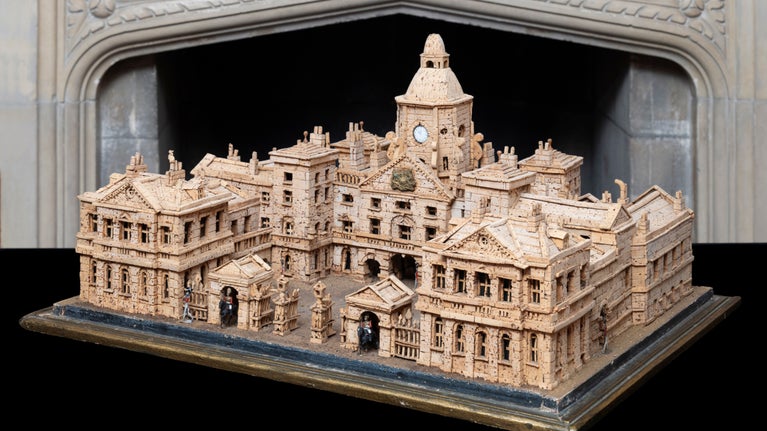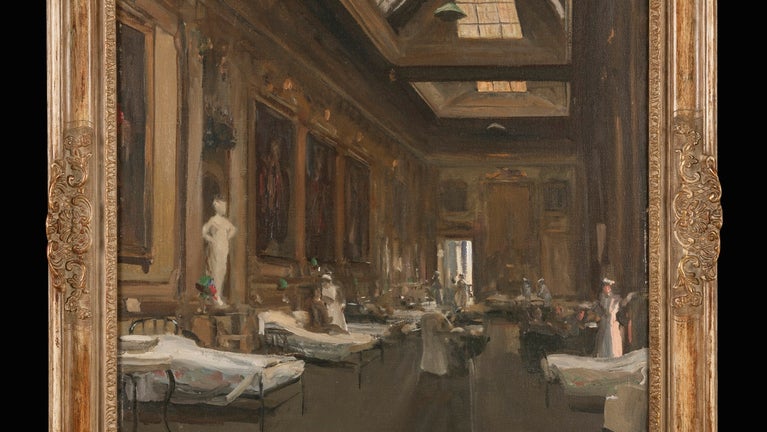
Art and collections
We care for one of the world's largest and most significant collections of art and heritage objects. Explore the highlights, our latest major exhibitions, curatorial research and more.

We’re developing our collections by acquiring items with a connection to the places we care for, so they can be enjoyed by current and future generations. Discover some recently added items and the stories behind them, from objects that have been kindly donated, to those purchased at nail-biting auctions.
If you would like to offer us an item that's linked to one of our places, find out here how to donate objects.
This atmospheric 1918 painting by Sir John Lavery (1856–1941), offers a rare glimpse into the Ball Room of Londonderry House – once a grand London residence, now lost to time after its demolition in 1962.
The scene is both intimate and poignant, capturing a moment of care and calm amid the chaos of the First World War. Londonderry House was the city home of Charles Vane-Tempest-Stewart, 7th Marquess of Londonderry, and his wife Edith, whose main estate was Mount Stewart in County Down. Charles and Edith transformed the house into a hospital and a haven known as 'the Ark' – a place where wounded soldiers and other guests could find comfort and escape.
Since joining the collection, the painting has been carefully conserved, including the addition of a new frame that reflects the artist’s original vision. It was acquired by Private Treaty Sale, with the support of Art Fund and another fund set up by the late Simon Sainsbury. It will be on public display at Mount Stewart in late 2025.

This group of artworks – formerly in the collection of Sir Brinsley Ford (1908–99) – was accepted under the Cultural Gifts Scheme by HM Government and allocated to us at Osterley Park and House, London. Sir Brinsley was a dedicated collector, scholar and supporter of the arts, with a particular interest in the Grand Tour – the extended European travels undertaken by wealthy British people in the 18th century. His collection, built around this theme, reflects the artistic and cultural influences that shaped British taste during that period.
Among the items now on display are Sir William Hamilton’s influential study of Mount Vesuvius; a portrait of Sir Humphrey Morice by Pompeo Batoni; and a portrait of Henry Lyte by Raphael Mengs. Both Batoni and Mengs were artists closely associated with Grand Tour portraiture.
A striking mahogany sideboard, once owned by the Victorian prime minister Benjamin Disraeli, 1st Earl of Beaconsfield (1804–81), was donated to us at Hughenden in Buckinghamshire. The piece of furniture, possibly made by the respected firm Gillows of Lancaster, was sold following Disraeli’s death.
In 1952, the sideboard was purchased for £10 (roughly £300 today) by Tom Parker, co-founder of the Parker Knoll Furniture Company. Thanks to the generosity of Mr Parker’s descendants, it's now on display in its original setting in Hughenden's dining room, adding a tangible connection to Disraeli’s life and legacy.

We care for one of the world's largest and most significant collections of art and heritage objects. Explore the highlights, our latest major exhibitions, curatorial research and more.
From goldwork and gilding to goldsmithing and jewellery making, discover the ways in which gold has been used in the objects in our collections.

The 13,000 oil paintings in our care are nearly all displayed in the houses of their historic owners. Learn about the stories behind a selection of the artworks and their owners.

Explore the evolution of carriages and their changing fashions, from the one with the disreputable image to the one with a royal seal of approval.
